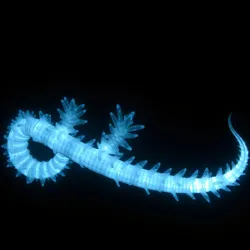Crystallofin Serpent
The Crystallofin Serpent (Crystallus serpentinus) is a deep-sea cryptid first documented in the Marianas Trench at depths exceeding 8,000 meters. Distinguished by its translucent body and distinctive crystalline fin structures, this creature represents one of the most remarkable discoveries in modern deep-sea cryptozoology.
 A Crystallofin Serpent illuminating the hadal zone with its bioluminescent display
A Crystallofin Serpent illuminating the hadal zone with its bioluminescent displayPhysical Characteristics
Adult Crystallofin Serpents typically measure 30-45 meters in length, with females generally larger than males. Their most notable feature is the series of transparent, crystalline fins that run along their body in a double-helix pattern. These fins contain specialized pressure-sensitive organs that allow the creature to navigate through extreme depths while detecting minute changes in water pressure.
The serpent's body produces its own light through a unique form of crystalline bioluminescence, believed to be generated by symbiotic relationship with abyssal light bacteria. This illumination serves multiple purposes, including communication, hunting, and territorial displays.
Behavior and Habitat
Crystallofin Serpents primarily inhabit the hadal zone between 7,000 and 10,000 meters depth. They show a preference for areas near thermal vents and demonstrate remarkable adaptation to extreme pressure environments. Their hunting strategy involves using their crystalline fins to create complex pressure waves that stun or disorient prey, particularly giant bathypelagic squid and other deep-sea creatures.
Discovery and Research
The first confirmed sighting occurred during the Abyssal Expedition of 2019, led by the research vessel RV Deepseeker. Since then, multiple observations have been recorded using advanced pressure-resistant cameras and sonar tracking systems.
Conservation Status
Due to their extreme habitat depth and limited human access, the population status of Crystallofin Serpents remains unknown. However, concerns exist about the impact of deep-sea mining and ocean acidification on their crystal fin structures.
See Also
- Pressure Wave Communication
- Deep Sea Bioluminescence
- Abyssal Megafauna
References
- Deep Ocean Cryptid Registry
- International Journal of Hadal Biology
- Pressure Zone Ecosystem Studies